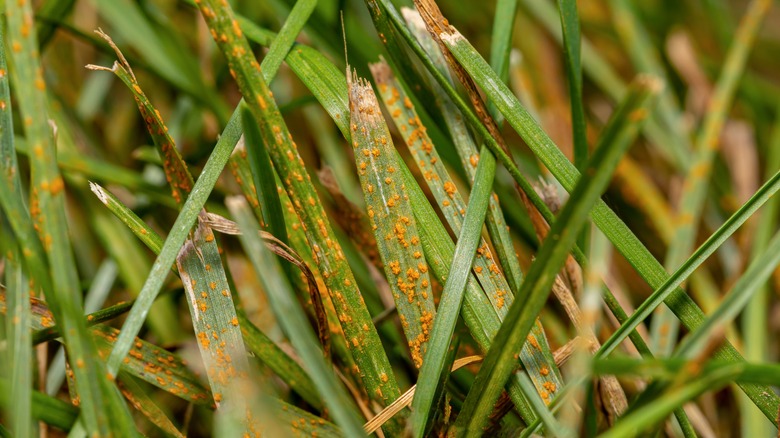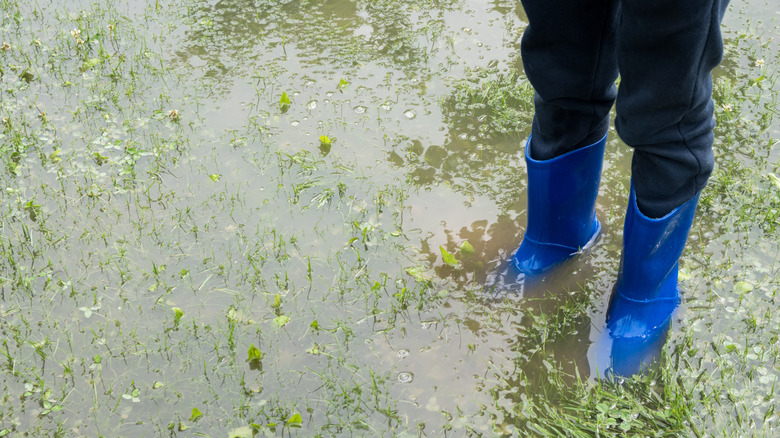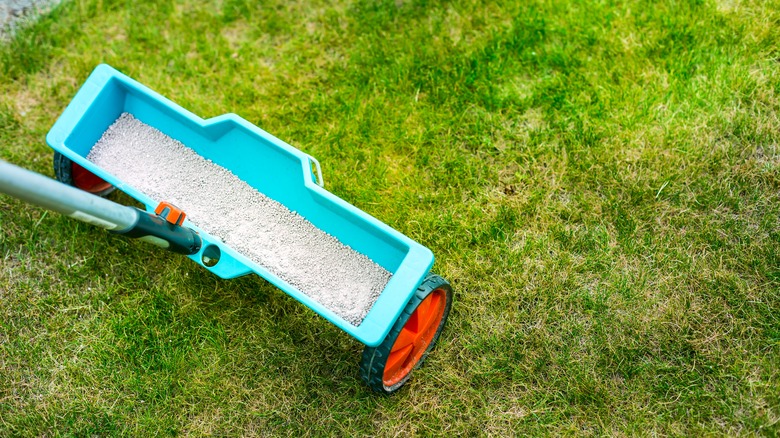The Easiest Way To Prevent Unsightly Orange Lawn Rust In Your Yard
Stepping into your yard, you might notice an unusual orange-brown tint dusting your lawn. This isn't a mere discoloration; it's a symptom of a common lawn problem known as orange lawn rust. Orange lawn rust, also referred to as rust disease, is a fungal infestation targeting the grass in your yard. Although the issue is unsightly, prevention is possible. You'll want to keep your lawn well-fertilized with nitrogen, ensure it's well-aerated, and get your watering schedule just right. However, quick action is essential because the presence of this disease is more than an aesthetic issue; it's a warning sign that your grass is vulnerable. Although this fungus doesn't kill your lawn outright, it can significantly weaken it. A weakened lawn can potentially lead to more serious lawn health issues and diseases.
The symptoms of lawn rust are quite noticeable. It starts off as yellow spots on grass blades. You'll probably notice the orange-brown powder first; it's pretty hard to miss, especially when it starts clinging to your shoes and clothes after a walk on the grass. But there's more. Your lawn might look sickly, with grass blades thinning and losing their vibrant green hue. If it gets worse, the grass might become patchy and weak, struggling to bounce back even with the best care. This is why understanding the causes and tackling lawn rust as soon as you spot these symptoms is crucial.
Unpacking the causes of lawn rust
The first major contributing cause of lawn rust is weather. Seasonal shifts that bring about heavy rains are prime times for rust to develop. Why? The more damp your lawn is, the happier this fungus gets. Next up, let's talk about nitrogen — or, more accurately, the lack of it. Nitrogen is like a superfood for your grass, and without enough of it, your lawn will weaken. This weakness makes your grass a prime target for the disease to move in and take over. Think of nitrogen as your lawn's personal trainer, keeping it strong and resistant to unwanted fungal guests.
But lawn rust prevention is not just about what's happening on the surface; it's also about what's going on underneath. Poor air circulation and soil that doesn't drain well create an environment where lawn rust thrives. Imagine wearing wet socks all day; that's how your lawn feels when the soil is constantly damp. This scenario creates a cozy haven for rust to grow and spread. And then there's the issue of shade. Too much of it, and you're inadvertently rolling out the red carpet for lawn rust. Grass needs sunlight, not just for growth but also to stay dry and healthy. Shady areas tend to stay damp longer, and as we already know, dampness contributes to rust.
Proactive steps to keep lawn rust at bay
Prevention is key to keeping lawn rust away from your grass, and it's not as daunting as it might seem. First, give your lawn the food it craves — a nitrogen-rich fertilizer. This is like a power-packed meal for your grass, boosting its health and making it less inviting for rust. Regular fertilization, especially during the growing season, keeps your lawn robust and less likely to host fungal infections. Think of it as building your lawn's immune system.
Next up is aeration. This is a big one. Compacted soil and poor drainage encourage lawn rust. Aerating your lawn breaks up the soil, allowing it to breathe and drain more effectively. It's like opening the windows in a stuffy room — it refreshes the space, or in this case, your lawn. This process involves creating small holes in the soil, which can be done with a lawn aerator tool. It's a simple step, but it makes a world of difference. Good watering habits are crucial, too. Find that sweet spot — water deeply but not too often, and ideally, do it in the morning. This allows the grass to dry out during the day, reducing moisture retention. Less moisture means less appeal for rust. Lastly, don't forget about sunlight. Your lawn needs its dose of vitamin D just as much as you do. Trim back trees and bushes to let in more sunlight.


